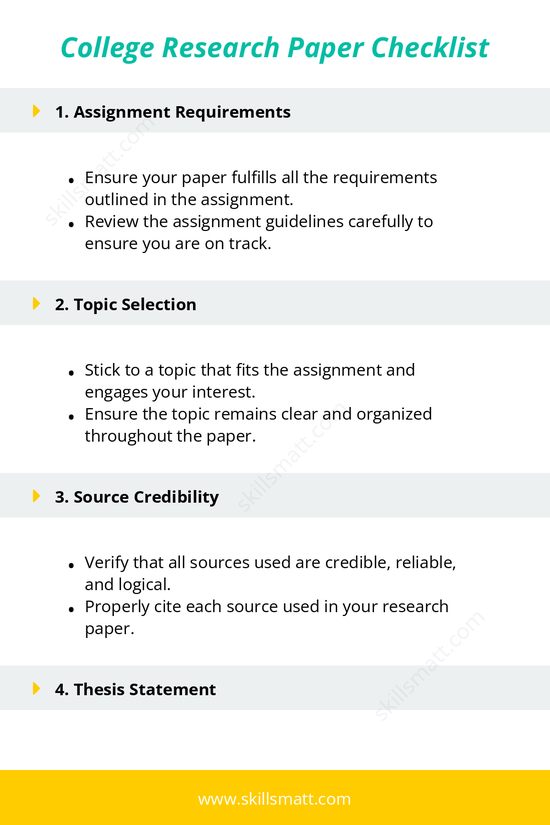College Research Paper Checklist
Writing a research paper can be overwhelming, but following a structured checklist will help you stay organized and ensure that you meet all the necessary requirements. This checklist covers all the critical aspects of a research paper from assignment requirements to final submission.
1. Assignment Requirements
- Ensure your paper fulfills all the requirements outlined in the assignment: Carefully review the assignment instructions to ensure you understand the specific requirements and expectations. This includes the topic, length, formatting, and citation style.
- Review the assignment guidelines carefully to ensure you are on track: Double-check that you haven’t missed any key instructions. Make sure your research paper follows the structure outlined in the guidelines.
2. Topic Selection
- Stick to a topic that fits the assignment and engages your interest: Choose a topic that not only fits the scope of the assignment but also sparks your interest. A passionate approach to your topic will result in a more compelling paper.
- Ensure the topic remains clear and organized throughout the paper: As you write, ensure that the topic stays focused and clear. Avoid deviating from the central theme or introducing irrelevant information.
3. Source Credibility
- Verify that all sources used are credible, reliable, and logical: Use reputable sources such as academic journals, books, and authoritative websites. Avoid relying on unverified or biased sources.
- Properly cite each source used in your research paper: Proper citation is essential to avoid plagiarism. Use the correct citation style and ensure that every source is acknowledged in the bibliography or reference list.
4. Thesis Statement
- Ensure your paper has a clear and arguable thesis statement: Your thesis should make a clear, specific claim that can be supported with evidence. A weak or vague thesis can weaken your paper’s overall argument.
- The thesis should be well-crafted and clearly connected to the body of your paper: Every paragraph in the body of the paper should support or relate back to your thesis statement. Ensure consistency in your argumentation.
5. Paper Organization
- Organize your paper in a clear and logical structure: Follow a structured outline that organizes the introduction, body paragraphs, and conclusion in a way that flows logically for the reader.
- Make sure your writing is easy to follow and understand: Maintain clarity by using concise language and ensuring smooth transitions between paragraphs and ideas.
6. Plagiarism Check
- Double-check for any plagiarism by citing all quotations and paraphrases: Ensure you properly attribute ideas and quotes to their original sources to avoid plagiarism. Use plagiarism-checking tools if necessary.
- Ensure all borrowed ideas and direct quotes are properly attributed: Whether paraphrased or quoted directly, ensure that you give credit to the original authors.
7. Proofreading
- Proofread your paper multiple times for content, grammar, and spelling errors: After writing your paper, proofread it several times to check for any errors in grammar, spelling, punctuation, and overall flow.
- Check for overall improvements and readability: Focus on improving clarity, conciseness, and the overall readability of your paper. Ensure that your argument is easily understood by the reader.
8. Formatting
- Ensure the paper is formatted according to the specified style guide (MLA, APA, Chicago, etc.): Adhere to the formatting guidelines provided, whether MLA, APA, or another style guide, to ensure your paper is properly formatted.
- Follow the teacher's specific instructions for formatting: Pay attention to specific formatting requirements, such as font size, margins, spacing, and citation style as outlined by your professor.
9. Submission Preparation
- Be prepared to submit your paper on time: Ensure that your paper is completed and ready for submission before the deadline. Late submissions may result in penalties.
- Understand the submission process and follow the teacher's instructions for submission: Familiarize yourself with how and where to submit your paper, whether online or in person. Follow any submission guidelines provided by your professor.


